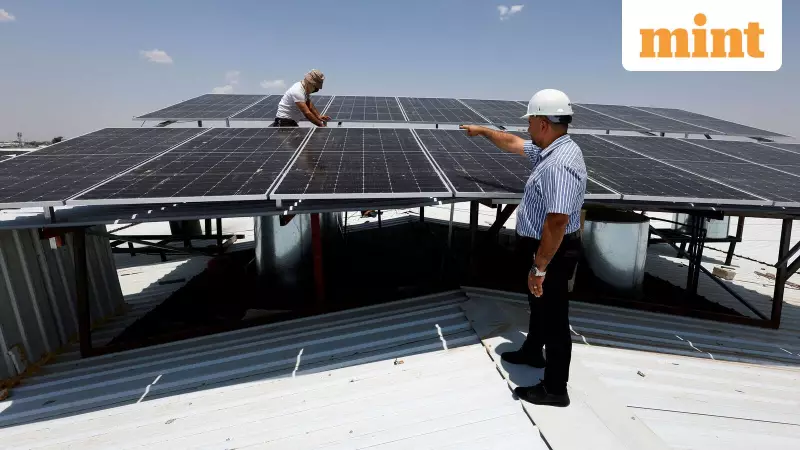
As world leaders prepare for the COP30 climate summit in Belém, Brazil, a stark warning emerges from economic experts: the current global approach to climate action may be creating more problems than it solves. According to V. Anantha Nageswaran, Chief Economic Advisor to the Government of India, well-intentioned climate plans risk plunging societies into what he calls 'the entropy trap.'
The Entropy Trap: When Good Intentions Backfire
The core issue lies in the fundamental mismatch between the complexity of climate solutions and the capacity of nations to manage them. The global push for rapid decarbonization is adding systemic complexity faster than countries can develop the institutions, infrastructure, and financial systems needed to absorb these changes. This creates a dangerous situation where climate action itself becomes a source of instability and disorder.
Nageswaran explains this using thermodynamic principles: Modern economies function as vast systems of continuous energy transformation. Every economic activity—from manufacturing to digital streaming—represents a thermodynamic process that naturally increases entropy, or disorder. For centuries, advanced economies managed this entropy through dense, stable energy sources like coal, oil, and gas that powered predictable systems and built social resilience.
Real-World Examples of System Strain
The theoretical concerns are already manifesting in practical problems across developed nations. In the Netherlands, rooftop solar adoption has surged beyond the capacity of distribution networks. Utilities now refuse new solar connections, producers face curtailment despite abundant sunshine, and industrial users bear rising congestion costs. This creates the paradox where green energy abundance leads to infrastructural scarcity.
Spain experienced widespread power disruptions in April not due to insufficient renewable generation, but because its grid couldn't maintain stability under high levels of intermittent supply without adequate balancing and storage capacity. If technologically sophisticated nations struggle with these conditions, the implications for developing countries with weaker infrastructure are far more serious.
Across Europe, Australia, and parts of the United States, similar patterns emerge: rising curtailment rates, lagging storage development, increasing balancing costs, growing wholesale market volatility, and multiplying transmission bottlenecks. These represent failures of timing and system design rather than failures of renewable technology itself.
Developing Countries Face Greater Risks
The situation becomes particularly concerning for developing economies. These nations typically operate with weaker grids, limited fiscal space, more power-sensitive industrial systems, and societies more vulnerable to shocks. Most developing countries have grids with minimal redundancy, thin transmission networks, inadequate storage, and insufficient balancing mechanisms. Introducing large volumes of intermittent energy could undermine reliability, industrial competitiveness, and public trust.
The transition also demands enormous upfront capital investment—resources that might otherwise fund critical needs like healthcare, education, and basic infrastructure. Manufacturing, essential for development, depends on stable baseload power. Intermittent energy sources can hinder investment, undermine export competitiveness, and threaten job creation. Since poorer households spend a higher percentage of their income on energy, price spikes or outages carry severe social and political consequences.
A More Realistic Path Forward
Nageswaran argues that the solution isn't abandoning climate ambition but sequencing the transition more intelligently. Adaptation should take priority in developing countries, as most climate-related losses stem from vulnerability rather than emissions directly. Building coastal protections, heat resilience systems, improved water infrastructure, and climate-smart agriculture reduces entropy by increasing stability and lowering risk.
Renewable energy expansion should proceed in proportion to grid readiness, storage availability, industrial needs, and fiscal capacity. Uniform timelines across countries with vastly different capabilities increase disorder rather than building resilience. Technology sharing covering advanced grid software, power electronics, storage solutions, and transmission innovations becomes essential.
Financial structures also need redesign. Developing countries require large-scale risk-sharing arrangements, including sovereign guarantees from advanced economies and deeper capital pools anchored by multilateral institutions, rather than additional project loans that increase debt burdens.
The message for COP30 is clear: climate goals cannot be achieved by pushing vulnerable societies into higher entropy states. A mitigation-first, transition-fast model risks destabilizing grids, slowing industrialization, straining public finances, and weakening overall resilience. The alternative framework emphasizes growth as the foundation, immediate adaptation measures, renewables scaled according to capacity, and technology and finance aligned with developmental needs.
The second law of thermodynamics serves as a crucial warning: systems that increase complexity without corresponding increases in stabilizers will inevitably fail. A stable climate requires stable societies, and stability ultimately depends on development powered by growth, supported by technology, and financed with fairness.





